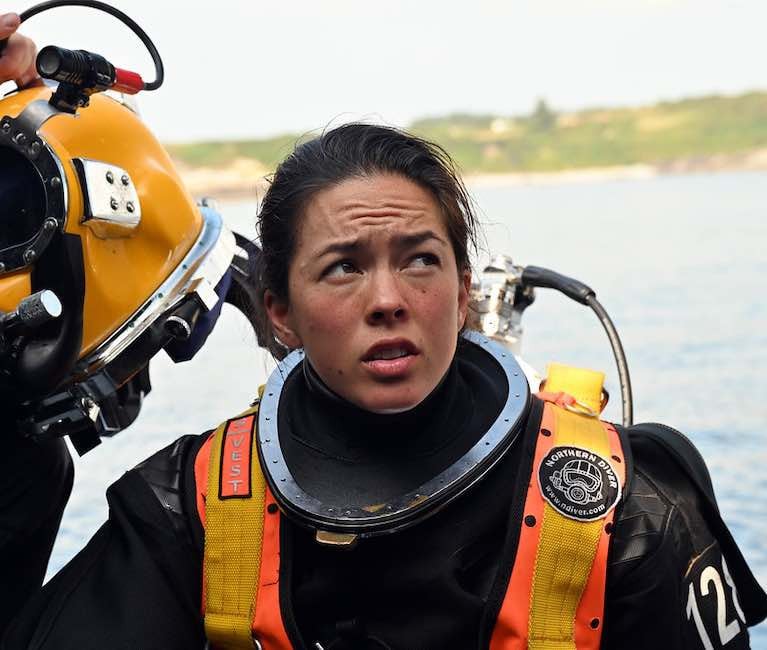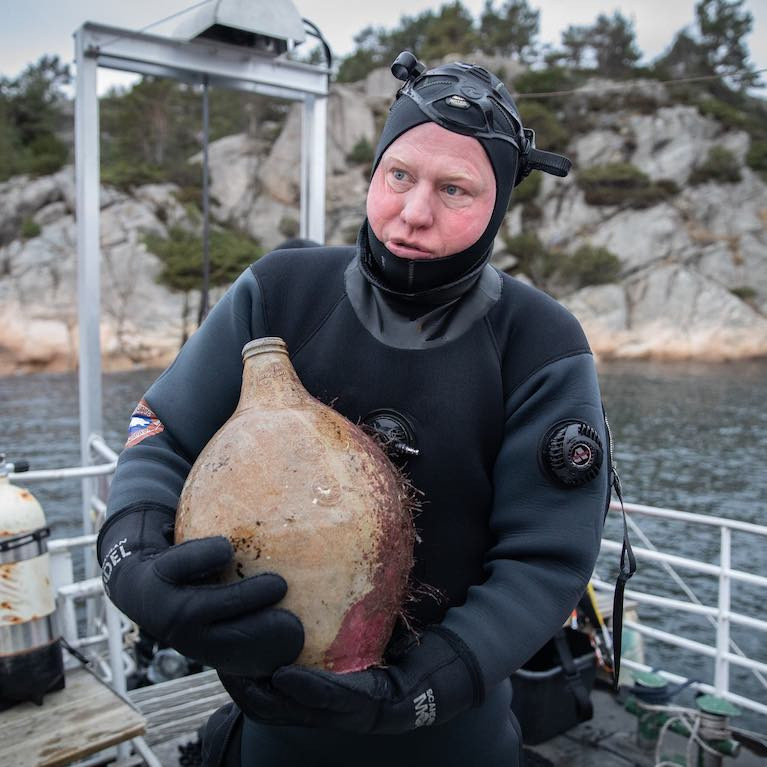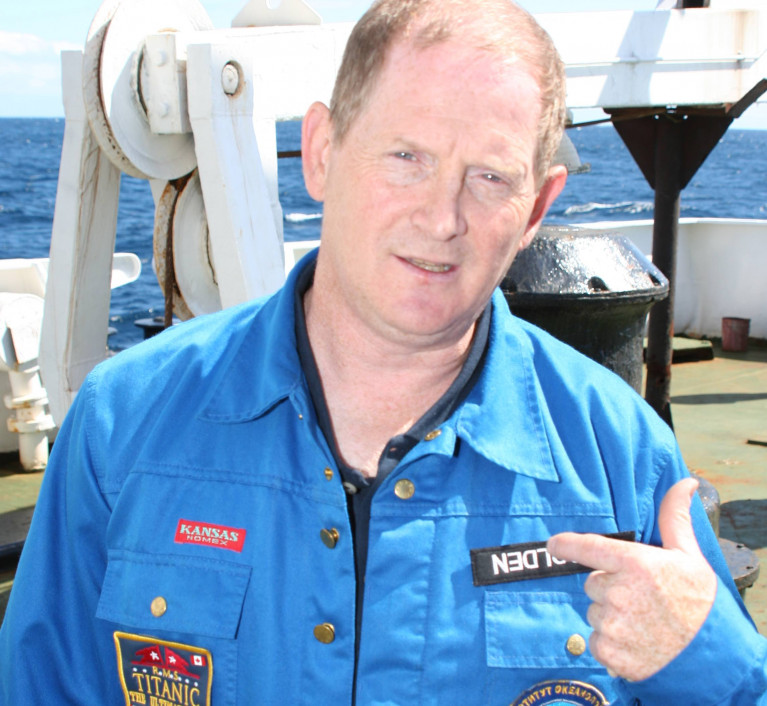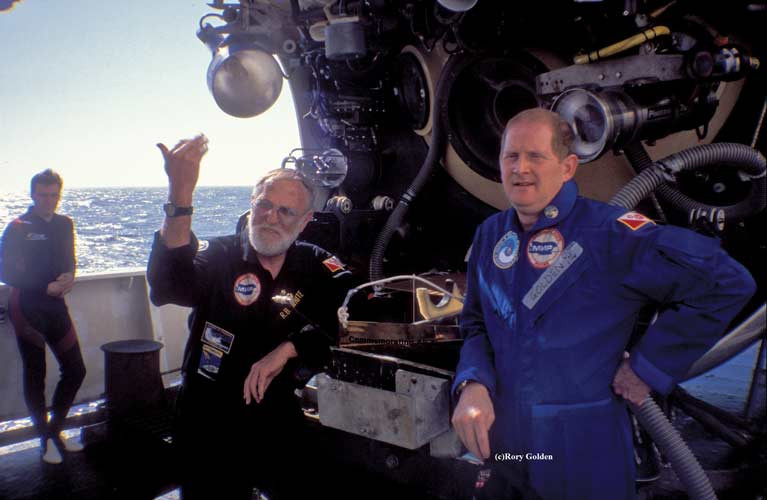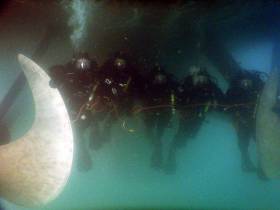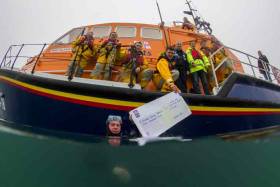Displaying items by tag: diving
Tributes to Michael Moriarty, Pioneer of Irish Scuba Diving
Tributes have been paid to Col Michael Moriarty, one of the pioneers of scuba diving in Ireland, who died earlier this month.
As The Sunday Independent reports, wetsuits were unheard of when he took up diving, and he once described how “we would just launch ourselves from the shore or rocks, wearing big lumpy woollen clothing, to give us the illusion of being warmer”.
Described by friends and colleagues as “big-hearted”, generous and full of both integrity and energy, the Army officer served on a number of UN peacekeeping missions until his retirement at the rank of colonel in 1992.
Born in Bandon, Co Cork, on December 21, 1931, Moriarty spent part of his childhood in Listowel, Co Kerry, where he was drawn to the sea from an early age.
He recalled his diving career in his first book, Submerged: a Lifetime of Diving, published by Comhairle Fo-Thuinn (CFT), the Irish Underwater Council, in 2001.
Close friend Ronnie Hurley, recalls how Moriarty introduced him to diving "in a lovely rocky cove" off Spanish Point in Co Clare.
 Michael Moriarty with the Glaucus trophy for spear fishing
Michael Moriarty with the Glaucus trophy for spear fishing
Moriarty gave Hurley a loan of his latex drysuit and showed him how to use twin corrugated-rubber breathing hoses – for this was before development of the non-return valve.
In Submerged, Moriarty charted the revolution in the sport after a French gas company engineer, Émile Gagnan, was asked by the French underwater explorer and navy captain Jacques Cousteau if he could develop a better breathing device. Cousteau then refined the open circuit valve or diving regulator developed by Gagnan.
Moriarty described how The Silent World, which Cousteau co-wrote with Frederic Dumas, became his “Bible”. Spear fishing was popular at the time, and Moriarty and colleagues represented Ireland in several international competitions. After CFT was founded in the Curragh in 1963, Moriarty became honorary secretary from 1964 to 1972 and president in 1973.
 Col Michael Moriarty, pioneering diver who served on many UN missions
Col Michael Moriarty, pioneering diver who served on many UN missions
Fellow CFT committee member and former Army officer Shane Gray, who was also taught to dive by Moriarty, recalled that he was a “man of integrity, a big hearted, generous man, honourable, honest and full of energy for his work and for his hobbies, chiefly photography and diving”.
Garda Commissioner Drew Harris has been asked to recognise the bravery of two gardai who played a key role in a harrowing cave rescue in north Mayo 25 years ago.
Retired chief superintendent Tony McNamara made the appeal at an event at Lacken pier in north Mayo at the weekend to mark the 25th anniversary of the death of diver Michael Heffernan.
Heffernan, a member of Mayo’s Grainne Uaile Sub Aqua Club, lost his life while trying to rescue three members of a family who were trapped in the back of a sea cave near Belderrig on October 25th, 1997.
German national Will Ernst von Below also died when his new currach capsized in a sea cave at Horse Island, throwing his friends, Tony and Carmel Murphy and their young daughter Eimear into the sea.
Up to 100 people, including Commissioner Harris, Heffernan’s widow Ann Marie and daughter Michelle, members of the Murphy family and Irish Coast Guard director Eugene Clonan attended the event, which was hosted by a Grainne Uaile Sub Aqua Club team, including diver and councillor Michael Loftus.
Five wreaths were laid, with one of the wreaths also remembering the Lacken drownings of 1927 in a storm which also claimed lives off Cleggan and the Inishkea islands.
Three Scott medals for bravery were awarded to Garda members Ciarán Doyle, David Mulhall and Sean O’Connor for their role in the Belderrig cave rescue, which was one of the longest in recent Coast Guard history and involved about 100 people attached to 21 different services.
National marine bravery awards were also given to the gardai, and to Grainne Uaile diver Josie Barrett, Killala Coast Guard members Séan McHale and Martin Kavanagh and fishermen Martin and Patrick O’ Donnell.
Garda divers Kieran Flynn and Joseph Mulligan were commended for their role, but were passed over for Scott medals at the time.
 he large gathering at Mayo’s Lacken Pier to mark the 25th anniversary of the Belderrig cave rescue which claimed the lives of diver Michael Heffernan and Will Von Below Photo: Michael Loftus
he large gathering at Mayo’s Lacken Pier to mark the 25th anniversary of the Belderrig cave rescue which claimed the lives of diver Michael Heffernan and Will Von Below Photo: Michael Loftus
McNamara said he had recommended that all five Garda divers should receive Scott medals for their efforts, and it was still one of his regrets that the bravery of both men was “overlooked”.
Addressing Commissioner Harris, who travelled to the event in north Mayo at the weekend, McNamara asked him “respectfully” if he might “have someone look at it again”.
“It’s never too late to undo a wrong,” McNamara said.
McNamara recalled how he had just arrived in Achill for the weekend when he got a phone call from the Garda station that four people had failed to return to Belderrig harbour from a boat trip, and a search was underway.
He recalled how Grainne Uaile club members Michael Heffernan and Josie Barrett attempted a dive, on a safety line, into the cave where the Murphys were trapped, assisted by their club colleagues and members of the Killala Coast Guard unit. Both divers were separated in violent sea conditions, and Barrett managed to make it back out.
The Irish Coast Guard helicopter from Shannon was asked to fly to Dublin to collect the five Garda divers, and efforts were made to identify and illuminate a landing area near the pier at Belderrig.
McNamara recalled how helicopter pilot Capt Dave Courtney wrote about the incident in his book, Nine Lives, describing how the aircraft was “greeted by an amazing sight…the landing site was illuminated by huge standing floodlights positioned at each corner of a large field”.
“We could see firemen with extinguishers, ambulances, Coast Guard members and Gardai. And in the shadows beyond, we could see the others, the locals, the community, unknown people just trying to help,” Courtney wrote.
Three of the Garda team, Sean O’Connell, Dave Mulhall and Ciaran Doyle, attempted to enter the cave underwater with the assistance of Sean McHale and Martin Kavanagh on the Killala Coast Guard rib but were beaten back by swell and currents. The boat was swamped, and its engine was smashed on the rocks, meaning.
“Fortunately, all five men made it safely to the back of the cave where they discovered that the three members of the Murphy family had somehow survived their ordeal; they also, tragically, found that Michael Heffernan and another man, Will Van Below had not survived,” McNamara said.
He recalled the key role played by Garda Ciaran Doyle, who volunteered to swim from the back of the cave with a rope which would then tow seven people on board the Coast Guard rib to safety.
Mayo fishermen Pat, Martin and Tony O’Donnell and the RNLI Ballyglass lifeboat assisted with radio communications, and Pat O’Donnell took Ciaran Doyle on board when he emerged, exhausted, at the cave mouth.
“Taking the tow rope on his bow and to keep his propeller clear of the rocks, Pat O’Donnell proceeded astern, a most difficult manoeuvre, to steer a boat in a straight line going astern, to keep off the rocks close by,” McNamara said.
“He was assisted in this by his brother, Martin, establishing a tow line to his boat and going ahead to keep the main towline to the Coast Guard rib as straight as possible, as it was successfully pulled from the cave,”he said.#
Garda divers Kieran Flynn and Joe Finnegan were taken into the cave by fisheries inspector Michael Hughes to recover the bodies of Michael Heffernan and Will Von Below, McNamara said.
McNamara noted that the State subsequently named the highest marine gallantry awards after Michael Heffernan, and the diver, whose wife was expecting their second child when he died, was posthumously awarded the first gold medal.
Diving & Snorkelling Trips Return to Dublin Bay
After a long break due to COVID, recreational diving is back on Dublin Bay and divers were out over the past two weekends at Dalkey Island and other popular bay sites.
A class of open water students got back into the water after a long break for a snorkel.
Local boat bives are also now fully operational in Dublin Bay again with regular departures to favourite dive sites around Scotmans Bay, Dalkey Island and the Muglins Beacon.
 The Ocean Divers 'Ocean Enterprise' RIB takes divers out into Dublin Bay from Dun Laoghaire
The Ocean Divers 'Ocean Enterprise' RIB takes divers out into Dublin Bay from Dun Laoghaire
Ocean divers, a dive firm that operates from Dun Laoghaire Harbour, says on social media, it is now running snorkel and boat trips over the next couple of weeks as the 2021 season reopens.
Mullingar's Dave McGowan, known for his recent achievements in the sport of freediving, takes his place on the podium once more. Last week, at the Aida International Blue Ocean Freedivers Pool Competition in Dahab, Egypt, McGowan took the Male Honours in both disciplines that he participated in and also took the overall gold.
 Dave McGowan prepares for a freedive
Dave McGowan prepares for a freedive
Day one of the competition did not necessarily go to plan, with a malfunctioning dive computer contributing to McGowan overshooting his target, coming very close to losing consciousness on the surface and ultimately receiving a red card and disqualifying his dive of 162m, which took approximately 2minutes and 45 seconds. McGowan was quoted saying, "This dive of 162m was huge for me, I had built up to a distance of 135m in training and was confident that I could do 10-15m more on the day of the competition but certainly not almost 30m extra. I had been relying on the computer to give me a good idea of when I could surface and when it didn't work it had me questioning the distance that I had already covered, trying to work this kind of thing out at the end of such a long swim on one breath is not an easy thing. The mind becomes foggy and basic tasks rely on an element of the subconscious to get you through it. I essentially got it wrong and ended up swimming almost another complete length of the pool. I was surprised to be told that I had covered 160m+ when in my head I had barely made 135m." Unfortunately, at the end of the dive, McGowan was not able to complete the 'Surface Protocol', which signals to the judges that he is ok and was subsequently shown a red card.
 Dave McGowan celebrates his win in the pool in Egypt
Dave McGowan celebrates his win in the pool in Egypt
McGowan returned on Day 2 determined to set the record straight. He completed his dive of 150m (equivalent to 6 lengths of a standard 25m pool) in the DYNb discipline (distance swam in pool on one breath using freediving fins) in a time of 2minutes and 35 seconds. This time he made a clean surface protocol, receiving a white card from the judges, legitimising his performance and confirming this dive as his 4th Irish National Record. "I wasn't really nervous leading into day one of this competition as I had approached my training in a conservative way and knew what I was capable of, however, arriving here on day 2 after what had happened on the first day I was feeling the nerves creep into the pit of my stomach. This sport is so psychological, it takes such mental strength, you really need to be able to control your thoughts and feelings and at times like these, in the moments before a record dive you have to be able to focus and get rid of any thoughts of negativity or doubts in your abilities. I feel like I handled it quite well and managed to complete what I had set as an upper limit for myself. I would have walked away satisfied with my performance and also with the record in anything above 132m, so to have been able to do 150m I really am over the moon – it was a difficult dive for me and for sure it will be difficult for anyone to beat in the future."
Day 3 saw McGowan return to finish off the competition with a 'fun' dive in the DNF or 'No-fins' discipline, (distance swam underwater on one breath in a style similar to the breast-stroke). In both depth and pool, this discipline is usually considered the most pure, and most original of all of the freediving disciplines, it is graceful to watch and more-so with the right training and technique, enjoyable to compete in. McGowan's swim of 116m in 2mins 19 secs places him 3rd of all time in the Irish rankings for this discipline.
Search & Recovery: The Challenging Role of the Navy Diver (PODCAST)
“We’ll always give our best, treat every incident as if it is one of our own.... and try our utmost to get a missing family member back to their loved one.....”
The words of Lieut Stephen Stack, head of the Naval Service diving unit, speaking about what keeps his colleague “motivated and driven to succeed”.
Last year, Sub-Lieut Tahlia Britton from Rossnowlagh, Co Donegal, became the first female to qualify for the Naval Service diving unit. A former champion surfer, she studied podiatry at NUI Galway but always wanted to join the military.
 Sub-Lieut Tahlia Britton enters the water from off a Navy RIB Photo: Davy Jones/Óglaigh na hÉireann
Sub-Lieut Tahlia Britton enters the water from off a Navy RIB Photo: Davy Jones/Óglaigh na hÉireann
She has described the mental and physical challenges of being a Navy diver in an interview recorded for RTÉ Seascapes, the full version of which is on a Wavelengths podcast this week (below).
Search and recovery is just one aspect of the work of Navy divers, which is, as Stack says “not glamorous...”
 Navy divers in training at Haulbowline Photo: Davy Jones/Óglaigh na hÉireann
Navy divers in training at Haulbowline Photo: Davy Jones/Óglaigh na hÉireann
One of the team’s recent challenging operations was the three-week-long search after the 12-metre steel-hulled boat, Alize, fishing out of Duncannon, Co Wexford, went down some 6½ miles off Hook Head, Co Wexford just over a year ago on January 4th, 2020.
 A briefing for a dive team at Haulbowline Naval base Photo: Davy Jones/Óglaigh na hÉireann
A briefing for a dive team at Haulbowline Naval base Photo: Davy Jones/Óglaigh na hÉireann
Joe Sinnott (65) from Kilmore Quay was recovered off Duncannon by the Irish Coast Guard Waterford-based Rescue 117 helicopter.
The body of skipper Willie Whelan (41), recently married and from Fethard-on-Sea, was located by the Hook Sub Aqua Club, and it was taken from the wreck of the new vessel by the Naval Service diving team.
“It was in very deep water, it was very complex, the weather wasn’t great, “Lieut Stack said, describing it as technically the most challenging operation he had been involved in recently.
He has paid tribute to the Garda Water Unit and the voluntary search and recovery groups that the Navy divers also work with in their aid to civil power role.
You can hear a taste of the aptitude test which aspiring Navy divers have to undergo at the Naval Service base at Haulbowline, along with interviews with Stack and Britton – including what she might sing underwater - below
Norwegian Divers Discover 300-Year-Old Wreck of Irish Sailing Ship
Norwegian divers have discovered a 300-year-old shipwreck of an Irish sailing ship on the sea bottom outside Mandal in Southern Norway.
The Irish ship, named "The Providentz", sunk in November 1720.
It is reported by the Norwegian NRK journalist, Siv Kristin Sællmann, that all crew members were saved, but the ship was left at the sea bottom. Divers and archaeologists are astonished by how well-preserved the ship and its possessions are.
The ship and most of the possessions will be left on the sea bottom for divers to explore freely.
Click here for a link to the article (text in Norwegian) but you can view more photos and a video of the wreck on the NRK TV website.
Dun Laoghaire Diver Rory Golden Returns to Titanic Wreck This Summer
Dublin Bay diver Rory Golden will join the 2021 Titanic Survey Expedition starting in May going back to the wreck after a gap of 16 years, and taking part in a “sea bed” breaking scientific expedition.
Golden has over 44 years of dive experience and played key roles in Titanic expeditions and dives in 2000 and 2005.
Citizen explorers, known as Mission Specialists, will work hand-in-hand with Golden and other scientific, archaeological, and oceanographic experts throughout the expedition.
“I will never forget the first time I saw the Titanic. We were travelling along the flat ocean floor towards the ship and we came upon a wall of mud,” recalls Rory Golden. “We were at the forward section, near the bow, and we slowly rose up a steel wall that was covered in rivets and rusticles. Eventually we ascended over the top and there she was. It was a rush of emotion. She is massive and awe-inspiring. You are excited, amazed, and, at the same time, you feel a deep sadness for all those lost. It is unlike anything else I have experienced in over 40 years of diving. In the five short years between my dives to the Titanic the changes were dramatic. I’m anxious to bear witness to the deep ocean’s impact on this historic sight,” says Golden.
 The bow of the Titanic Photo: Rory Golden
The bow of the Titanic Photo: Rory Golden
Rory is highly regarded in the dive and Titanic communities. As a member of the Explorers Club and Vice Chair of the Great Britain and Ireland Chapter, he has been an active explorer, diver, and researcher dedicated to the preservation of Titanic history. We are proud and excited to welcome him to our expeditionary team for the 2021 Titanic Survey Expedition,” says Stockton Rush, President, OceanGate Expeditions. “His knowledge and previous documentation of this revered shipwreck will help us navigate the features of the wreck site and assess how quickly the wreck is decaying,” continues Rush.
Six missions scheduled for Summer 2021 will mark the inaugural expedition of a multi-year effort to preserve Titanic history for future generations and document the rate of decay of the important site. Using an array of high-resolution 4K cameras, a laser scanner, and sonar equipment, OceanGate Expeditions’ team will create a fully explorable photorealistic virtual 3-D model of the site.
Each participating citizen scientist will embark on 8-days at sea as a Mission Specialist crewmember and make one untethered 8 to 10-hour submersible dive as part of a 5-person team (sub pilot, subject matter expert, three mission specialists).
Each submersible dive team will spend several hours exploring the renowned Titanic wreck-site. The Summer 2021 Expedition schedule runs late-May through mid-July.
Irish Diver Rory Golden Consulted on New Expedition to Recover Titanic's Wireless Marconi Telegraph
Irish deep-sea diver Rory Golden is providing expertise to a new expedition to the Titanic which aims to recover the Marconi radio from the wreck, The Sunday Times reports.
The wireless Marconi telegraph was instrumental in saving more than 705 passengers from freezing Atlantic waters when the ship sank after striking an iceberg off Newfoundland in April 1912 with the loss of almost 1500 lives.
As Afloat reported previously, the ambitious project to retrieve the most famous marine radio in the world from 2.5 miles down in the Atlantic has finally secured legal approval.
The new expedition planned by RMS Titanic Inc, the salvor-in-possession, will be led by Dr David Gallo and French former naval officer Paul Henri Nargeolet.
Dublin-based Golden, who was the first Irish diver to visit the wreck site in almost 4,000 metres of water, has been engaged as a consultant to the company which has recovered over 5,500 artefacts in eight previous expeditions.
The former managing director of Virgin Records Ireland was dive safety operations manager for the Operation Titanic 2000 project which recovered 800 items - including the main ship’s wheel which he spotted. He returned in 2005 for a second dive, which was recorded in a BBC documentary.
In March 2013 he was a member of the team sponsored by Amazon.com founder Jeff Bezos which salvaged five Apollo F-1 rocket engines from 4200 metres in the North Atlantic, including one from Apollo 11 which launched a man to the moon in 1969.
Golden’s participation is one of several Irish connections to the new diving expedition which is expected to cost at least 10 million US dollars.
A Mayo community’s support for the new venture also helped to secure recently approved US Admiralty Court permission for it.
A letter to the US Admiralty Court from Addergoole Titanic Society director Toss Gibbons, secretary Mary Rowland and public relations officer Frank Gibbons urged that it would “give its blessing” to RMS Titanic Inc to undertake the expedition. The society remembers 11 of the ship’s fatalities from the Mayo village of Laherdane and surrounding area.
“We spent a lot of time in Ireland, in Belfast and with the folks in Addergoole to put a plan together which would satisfy the court,” RMS Titanic Inc president Bretton Hunchak said.
The recovery of the Marconi telegraph is crucial to understanding “the story of all of the survivors”, Hunchak explained.
 The Marconi Telegraph room as seen from the top of the Titanic Photo: Rory Golden
The Marconi Telegraph room as seen from the top of the Titanic Photo: Rory Golden
“Ultimately, the Marconi radio system remains an unsung hero, responsible for countless generations of families that exist only because the radio cried out on behalf of their ancestors,” he said.
“ For that reason, we must recover this incredible piece of history, to rescue the radio that saved 705 lives from being taken from the world that fateful night."
 The hatch to the Marconi Room Photo: Rory Golden
The hatch to the Marconi Room Photo: Rory Golden
Hunchak said the original plan for the expedition was within a weather window between June and August of this year, and that might still take place.
“Obviously, with the Covid-19 pandemic, we have questions now and will make a decision on timing very shortly,” he said.
“The Marconi telegraph is recognisable, from our underwater photography, but if we recover it there will be considerable conservation required before we can take it around the world as part of our exhibition of artefacts,” he said.
Golden said the project was “fraught with a lot of unknown and known variables, such as the condition of the roof area, the wreck itself, currents, visibility” and other factors, but has “a very good chance of succeeding”.
The wreck of the Titanic was discovered by Dr Robert Ballard and Jean Louis Michel in a joint US/ French expedition on September 1st, 1985, some 963 miles northeast of New York and 453 miles southeast of the Newfoundland coastline.
More on the Sunday Times report here
Diving Section in Naval Service Hit Hard by Staffing Crisis
Divers of the Naval Service which form an elite unit in the force is operating at less than a quarter of its intended capacity as a result of the Defence Force’s retention crisis.
Naval Service Diving Section according to The Irish Times, is the only dive team in Ireland capable of carrying out deep sea operations. It has a wide variety of roles but its most prominent function is carrying out search and recovery operations for missing persons.
It carries out an average of 15 missing person searches every year, some of which last for up to two weeks at a time.
The diving section has an establishment strength of 27 divers but is operating with just six as a result of highly trained personnel leaving for the private sector. Moreover, the problem is compounded by a lack of replacements coming through.
The diving section has not been at full strength since before the reorganisation of the Defence Forces in 2012 which was marked by significant cuts to resources and a new manpower limit of 9,500.
Click here for further reading on the story.
Wexford Sub Aqua Club Present Kilmore Quay RNLI, with a Cheque for €1,000
Last Sunday, Wexford Sub Aqua Club, presented the Kilmore Quay branch of the RNLI, with a cheque for €1,000. The presentation was done just before the crew went out for their scheduled morning training exercise.
This money was raised by members and friends of the club at their annual Christmas Swim.
This year’s swim was noticeable due to the temperature of the water, which swimmers commented on as being the coldest since the club started to do the event.
Swim organiser, Ivan Donoghue said that “it was so cold, that while swimmers walked to the waters edge, the sand was cracking under their feet. We braved the water for a few minutes, but the members of all the RNLI face such conditions on every call they go on. We thank everyone who took part, those who sponsored the swimmers and the Kilmore Quay RNLI for being there to protect the people who use the waters around the Saltee Islands”
The club’s next event is on Sunday April 22nd at 10.30am. It is a 5 mile fun run/walk around the scenic Kilmore Quay village and registration is at our clubhouse overlooking the Saltee islands. €10 entry for adults.
The club are currently in the process of teaching our five new members how to dive.


























